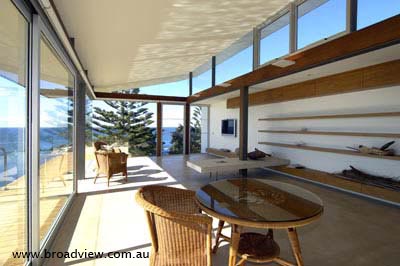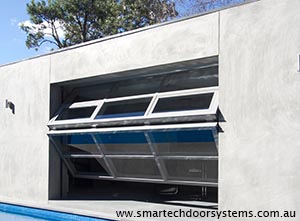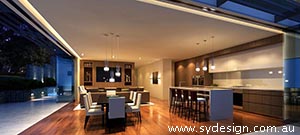
Aluminium sliding doors

Panel lift garage door used off a living space

Ensuring the look you want meets functionality & budget
There are some very important factors to consider when selecting a door whether it's standard or non-standard. You must think about what door you like aesthetically as well as how it needs to function.
Non-standard doors
Non standard doors include such doors as stacker sliders, bi-folds, panel lifts and operable walls. There are two different installation types and you need to select which one is suitable for your requirements. Is your door to be "bottom hung" or "top hung"?
Top hung units
Top hung doors load (or hang) from an engineered head beam above the door and are generally more expensive to buy and install. This is due to the fact that top hung doors require a more substantial beam above the door to not only take the load of the roof above a large opening but also to take the physical load of the door unit itself.
Top hung doors can provide a level floor transition from one space to another (see image to right). This requires a deep beam to be installed between the door head and roof structure. Some walls just don't have enough height to house a beam. So there needs to be a great deal of thought put into the door selection process very early in the design process.
Top hung doors can be purchased without the manufactures standard sill and can be fitted with a concealed sill, resulting in a seamless floor transition. These can be purchased from specialist door hardware suppliers and are to be fitted by your builder or carpenter.
As a result of higher costs and more effort required in the sill design process, bottom hung (or bottom loaded) doors are the most economical installation type for large openings.
Bottom hung units
Bottom hung doors load their weight onto the floor structure. Bottom hung units can be purchased in many different styles of doors just like top hung units but these units come fitted with a chunky sill that requires stepping-over when traversing.
Standard doors
Service doors
Service doors are front and rear entry doors. These doors need to be solid enough to provide security as well as weather protection, and (in some areas) bushfire attack. For this reason swinging solid timber doors are generally used. Glass can also be used very effectively but it should be double glazed, toughened or laminated, for security, bushfire protection and safety.
Most external door frames are made from solid timber or powder coated aluminium and come in two separate pieces, the frame and the leaf, these need to be installed by a professional carpenter.
Internal doors
- Hollow core - Hollow core doors are a sandwich type product, generally constructed of two external thin pieces of plywood and an internal cardboard centre. Most internal doors installed in Australian homes are hollow core and are very light and easy to close (typically 35mm thick). These doors are very cost effective but have very poor sound insulation, are not weatherproof and should not be used as external doors.
- Solid core - Solid core doors are constructed of solid timber and as a result have better acoustic properties and are perfect for private areas. This type of door is more expensive to buy than hollow core doors but can be detailed with panels to suit the style of your home. You will know if your existing door is solid core based on the sound when tapped, the weight as well as the thickness (nominally 45mm thick).
There are a variety of door formats that are manufactured in solid and hollow core options:
- Swinging. Single swinging doors are the most common, trouble free and secure internal door option. Double doors formats are also possible and are called either French or paired doors.
- By-pass slider. These unit types slide outside the face of wall and require a non-standard track. They can look very modern and industrial but are a more expensive option compared to a standard cavity slider. NOTE: If the slider opening width is larger than the average 820-920mm the door leafs will need to be purpose built and will also require a floor mounted guide. The track and guides can be purchased from specialist door hardware suppliers.
- Cavity slider. These need to be built into the house during construction. Rectifying track failure can be difficult but they are the most standard and cheapest option for internal sliders.
- Bi-fold. These concertina-like doors fold back on each other and stack against one wall. They are great for large openings but are more expensive than other door types and work best with a floor mounted guide.
